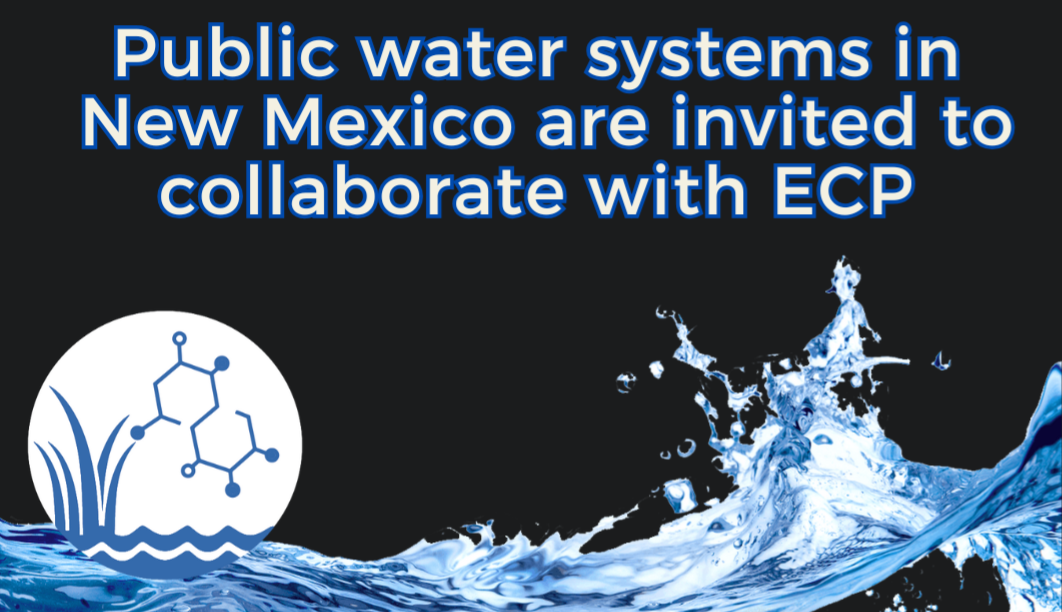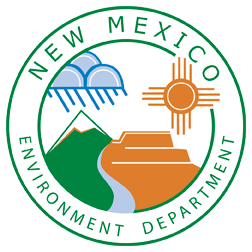PFAS: What are they?
Per- and polyfluoroalkyl substances (PFAS) are a group of synthetic chemicals that have been used for a large number of purposes since the 1950s.
PFAS have been used in food packaging, cleaning products, stain resistant carpet treatments, nonstick cookware and firefighting foam, among other products. Due to the widespread use of PFAS and the fact that they bioaccumulate, they are found in the bodies of people and animals all over the world, as well as ground and surface water.
PFAS contamination in New Mexico is one of the New Mexico Environment Department’s top priorities, as is the protection of human health and the environment.

Are PFAS harmful to your health?
The health effects of these emerging contaminants are still being studied, but research indicates that some PFAS may affect reproductive health, increase the risk of some cancers, affect childhood development, increase cholesterol levels, affect the immune system, and interfere with the body’s hormones.
On June 15, 2022, the Environmental Protection Agency (EPA) released four interim drinking water health advisories for PFAS and in April 2024, EPA finalized drinking water regulations for six PFAS chemicals at public drinking water systems. These updated guidelines and standards indicate that health effects might occur at lower levels than previously thought.
The lifetime health advisories are non-enforceable guidelines issued by EPA to provide technical information to state agencies and other public health officials on health effects, analytical methods, and treatment technologies associated with drinking water contamination.
Has drinking water in New Mexico been tested for PFAS?
NMED has taken proactive steps to begin evaluating PFAS impacts to public water supplies in New Mexico. As part of our efforts to protect communities PFAS in public drinking water, NMED, in collaboration with the U.S. Geological Survey (USGS) sampled drinking water supplies across the state. This sampling effort, which started in 2020 and continues today, has focused on multiple ground and surface water supplies across New Mexico.
Results from nearly 80 public water systems, as well as multiple surface water sampling locations, are available here.
Additionally, New Mexico public water systems are currently sampling for PFAS under the federal Fifth Unregulated Contaminant Monitoring Rule (see below).
U.S. EPA Unregulated Contaminant Monitoring Rule
EPA uses the Unregulated Contaminant Monitoring Rule (UCMR) to collect data for contaminants that are suspected to be present in drinking water and do not yet have health-based standards set under the Safe Drinking Water Act (SDWA). A select number of public water systems (PWS) are sampled under the UCMR.
Testing for the Third Unregulated Contaminant Monitoring Rule (UCMR3) occurred from 2013-2015. The EPA included six PFAS chemicals in this round of testing. Among 35 water systems tested in New Mexico, UCMR3 sampling returned only a single PFAS detection for PFHpA.
Testing for the Fifth Unregulated Contaminant Monitoring Rule (UCMR5) began in 2023 and will continue through 2025. This round of testing features 29 PFAS chemicals, including six that now have EPA drinking water regulations: PFOA, PFOS, PFBS, PFHxS, PFNA, and HFPO-DA (also known as GenX). (Note that the UCMR5 contaminant list was developed before standards for these six PFAS chemicals were finalized in 2024.) Lithium is also included in UCMR5 sampling.
The latest results of UCMR5 testing were released in October 2024. Of the PFAS contaminants with EPA drinking water standards, results indicate detections at five out of 49 PWS tested so far. The October 2024 UCMR5 data release represents 67% of the total number of results for New Mexico PWS that EPA will publish through 2025.
UCMR results for New Mexico are provided in the links below and UCMR5 results will be updated here as they are released.
- U.S. EPA Third Unregulated Contaminant Monitoring Rule (UCMR3) (posted 1/8/20, data collected 2013-2015)
- U.S. EPA Fifth Unregulated Contaminant Monitoring Rule (UCMR5) (posted 10/28/24, data collected through 9/3/24)
*Note: UCMR results are provided in units of micrograms per liter (µg/L, equivalent to parts per billion). To convert results in µg/L to ng/L, multiply the value by 1,000. Click here for an EPA summary of UCMR5 data.
Are PFAS regulated in drinking water in New Mexico?
On April 10, 2024, the U.S. Environmental Protection Agency (EPA) announced the first-ever national drinking water standards for several PFAS in drinking water. The final rule, establishes maximum contaminant levels for PFOA, PFOS, PFNA, PFHxS, and HFPO-DA (also known as GenX) as individual contaminants, and will regulate PFNA, PFHxS, HFPO-DA, and PFBS as a mixture through a Hazard Index.
This new rule will significantly reduce the level of PFAS in drinking water across the United States. Many states including New Mexico, have worked to monitor for PFAS exposure in drinking water. This rule builds on these efforts by incorporating the latest science and establishing a nationwide, long-term, health-protective level for these specific PFAS in drinking water.
In New Mexico, 563 community water systems and 128 non-transient, non-community water systems will be required to comply with this new rule.
For more information about this final rule, please visit the EPA Per- and Polyfluoroalkyl Substances (PFAS) rule summary page. EPA’s final regulatory standards for PFAS are as follows:
| PFAS Compound | Maximum Contaminant Level (MCL) | Maximum Contaminant Level Goals (MCLG) *** |
| PFOA | 4.0 ppt* | 0 ppt* |
| PFOS | 4.0 ppt* | 0 ppt* |
| PFNA | 10 ppt* | 10 ppt* |
| PFHxS | 10 ppt* | 10 ppt* |
| HFPO-DA (GenX) | 10 ppt* | 10 ppt* |
| Mixture of two or more: PFNA, PFHxS, HFPO-DA, and PFBS | Hazard Index of 1 | Hazard Index of 1 |
**Hazard Index is a tool used to evaluate potential health risks from exposure to chemical mixtures ***Maximum Contaminant Level Goal (MCLG): The level of a contaminant in drinking water below which there is no known or expected risk to health. MCLGs allow for a margin of safety and are non-enforceable public health goals.
The new PFAS rules also require public water systems to:
- Conduct initial and ongoing compliance monitoring for the regulated PFAS.
- Implement solutions to reduce regulated PFAS in their drinking water if levels exceed the MCLs.
- Inform the public of the levels of regulated PFAS measured in their drinking water and if an MCL is exceeded.
What are the initial timelines for these new rules?
The Safe Drinking Water Act generally provides a three-year timeframe for compliance with new rules. Because of the additional time required for capital improvements for systems to comply with the PFAS MCLs, the EPA is extending the typical three-year timeline for compliance to five years.
| Timeframe | Regulatory Requirement(s) |
|---|---|
| Within three years of rule promulgation (2024 – 2027) | Initial monitoring for the regulated PFAS must be completed |
| Starting three years following rule promulgation (2027 – 2029) | Results of initial monitoring must be included in Consumer Confidence Reports (i.e., Annual Water Quality Report) Regular monitoring for compliance must begin, and results of compliance monitoring must be included in Consumer Confidence Reports Public notification for monitoring and testing violations |
| Starting five years following rule promulgation (starting 2029) | Comply with all MCLs Comply with public notifications for MCL violations |
What should I do if my drinking water system has PFAS?
There are several technologies that have been proven effective in the removal of PFAS contaminants. Those technologies include Granular Activated Carbon (GAC), Ion Exchange Resin, and Reverse Osmosis (RO). If you are concerned about PFAS in your drinking water, NMED recommends you contact your local water utility to learn more about your drinking water and urge them to apply for the funding currently available for PFAS Treatment.
The standards in this new rule are set to reduce PFAS to the lowest levels that are feasible for effective implementation. If you are concerned about the level of PFAS in your drinking water, consider installing in-home water treatment (e.g., filters) that are certified to lower the levels of PFAS in your water. For more information: https://www.epa.gov/sdwa/and-polyfluoroalkyl-substances-pfas.
EPA Fact sheets on the new PFAS Rules
General Fact Sheet: EPA’s Final Rule to Limit PFAS in Drinking Water (pdf)
Frequently Asked Questions and Answers: Final PFAS National Primary Drinking Water Regulation (pdf)
Fact Sheet: Reducing PFAS in Your Drinking Water with a Home Filter (pdf)
Presentation: Overview EPA PFAS NPDWR (pdf)
Available Funding for PFAS Treatment
On November 15, 2021, President Biden signed the Bipartisan Infrastructure Law (BIL). As part of this historic law, the State of New Mexico will receive significant increases to its Drinking Water State Revolving Loan (DWSRF) programs over the next five years. These historic investments represent a unique opportunity to rebuild and replace New Mexico’s aging water and wastewater infrastructure and foster more resilient communities. EPA allows DWSRF funding to be used in combination with additional funding sources to finance water infrastructure projects, as well as to fund projects that will address emerging contaminants, such as PFAS.
New Mexico’s current (FY23) allotment of BIL funding includes the following:
- DWSRF Capitalization Grant Base Funds – $7,283,200
- DWSRF General Supplemental Funds (BIL) – $17,955,000
- DWSRF Emerging Contaminants (PFAS) –$7,540,000
To learn more about the DWSRF funding process and to submit a pre-application visit our NMED Water Infrastructure and Funding Page. Public water systems are encouraged to take action now while the funding is available to investigate contaminants and explore treatment options if needed.
Public water systems in New Mexico are invited to collaborate with the Emerging Contaminants Program (ECP).

• For more information about PFAS in drinking water, please contact: DWB.PFAS@env.nm.gov

